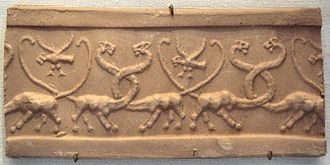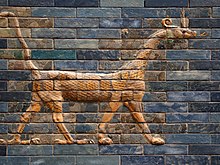Mušḫuššu
Mušḫuššu or Mušḫušḫu (Muš-ḫuš-šu, Muš-rušu, Sirruš, pronunciation probably Musch-chush-shu; Babylonian terrible snake ) is a "snake dragon", a hybrid of Sumerian mythology and was the companion animal of Enlil and Tišpak . It was later transferred to the Babylonian god Marduk . According to Nergal-šar-uṣur , Mušḫušḫu are good gatekeepers because they can spray an enemy with deadly poison.
Appearance

floating between two hooked snake lions Mušḫuššu (around 3000 BC),
today in the Louvre Paris
In connection with Tišpak, who is often depicted riding on the Mušḫušḫu, seven heads are often ascribed to him. He is described as a snake ( muš ) and a lion ( labbu ).
Myths
The struggle of Tišpak against Mušḫušḫu is described in an incomplete text from the library of Aššurbanipal (CT 13.33-34), which Wiggerman wants to date to the Old Akkadian period. The dragon was born of the sea ( tâmtu ). The myth describes its impressive size: the animal is 50 miles long, one mile wide. Its mouth is six cubits long and its ears twelve cubits. His abilities are correspondingly great: he can catch birds 60 cubits away and pull something out of nine cubits of water. When he lifts his tail, it touches the sky. All gods are fearful. Tišpak finally manages to kill the dragon with an arrow in a terrible storm, its blood flows for three years and three months, day and night.
iconography
Iconographically , Mušḫuššu is represented as a "red mixed snake creature", initially as a double-horned snake head with a scaled body. The front legs are those of a lion, the hind legs those of an eagle. At the end of the long and erect tail there is a scorpion stinger.
The oldest relief comes from Nippur and refers to a connection to Enlil. Probably the best-known depiction of Mušḫuššu can be found on the brick reliefs of the Ištar Gate , which Nebuchadnezzar II had installed there and which can be seen in the Museum of the Near East in Berlin .
literature
- Dietz-Otto Edzard and a .: Reallexikon der Assyriologie und Vorderasiatischen Aräologie , Vol. 1 , de Gruyter, Berlin 1993, ISBN 3-11-004451-X , p. 120
- Helmut Freydank u. a .: Lexicon of the Old Orient. Egypt * India * China * Western Asia, VMA-Verlag, Wiesbaden 1997 ISBN 3-928127-40-3
- Brigitte Groneberg: The gods of the Mesopotamia. Cults, Myths, Epen, Artemis & Winkler, Stuttgart 2004 ISBN 3-7608-2306-8
- WG Lambert: The History of the muš-ḫuš in Ancient Mesopotamia . In: P. Borgeaud (ed.), L'animal, l'homme, le dieu dans le proche orient ancien . Leuven, Editions Peeters 89-92, 1985.
- FAM Wiggermann: Tišpak, his Seal, and the Dragon mušḫušḫu . In: O. Haex et al. (Ed.), To the Euphrates and Beyond: Archaeological Studies in Honor of Maurits N. van Loon . Rotterdam, Balkema, 1989.
Web links
Individual evidence
- ^ WG Lambert 1985. The History of the muš-ḫuš in Ancient Mesopotamia. In: P. Borgeaud (ed.), L'animal, l'homme, le dieu dans le proche orient ancien . Leuven, Editions Peeters 87
- ^ Theodore J. Lewis 1996. CT 13.33-34 and Ezekiel 32: Lion-Dragon Myths. Journal of the American Oriental Society 116/1, 29th JSTOR 606370
- ↑ CT 13.33-34, lines 17, 20, 24 obverse, lines 4, 7, 9 reverse
- ↑ CT 13.33-34 obverse, lines 8-12
